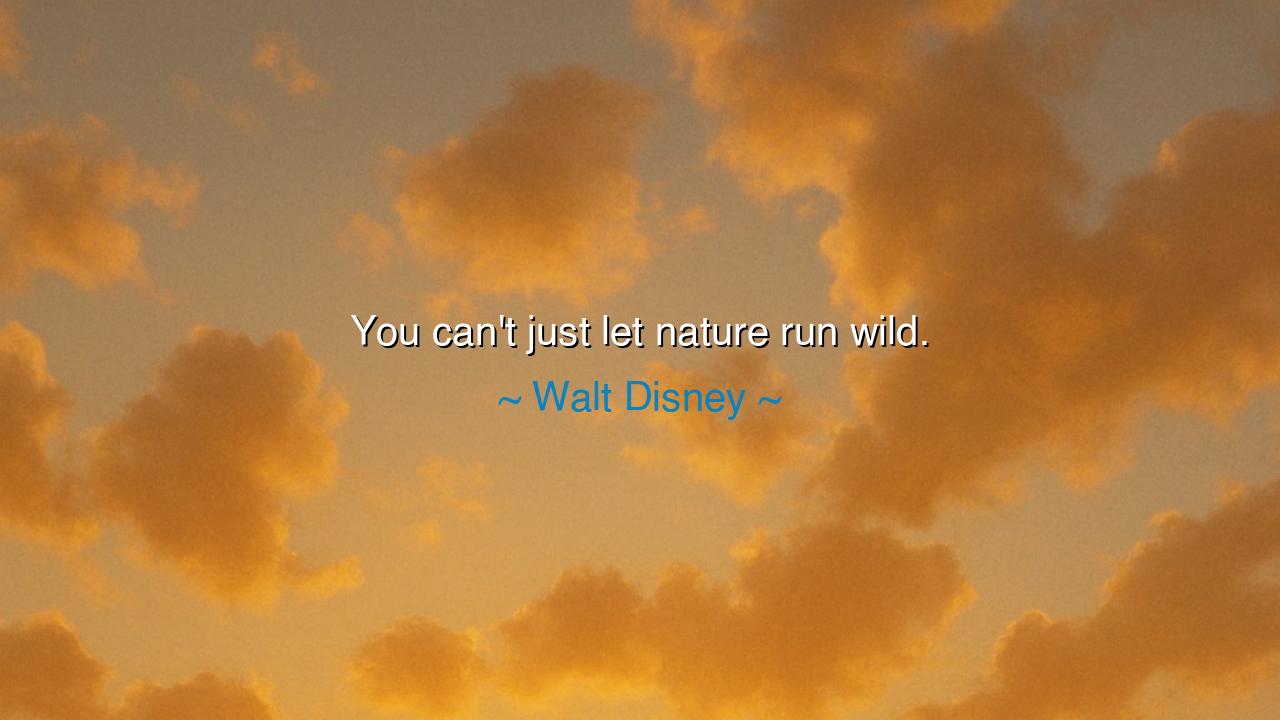
You can't just let nature run wild.






Walt Disney once declared: “You can’t just let nature run wild.” To many, these words may sound surprising, even paradoxical, for Disney was a dreamer who often celebrated the beauty of forests, animals, and the wonder of creation in his films. Yet this statement reveals not a dismissal of nature, but a recognition of its untamed power. Nature is both nurturing and destructive, both giver of life and bringer of storms. To simply let it run unchecked is to invite chaos, for the wild, left without guidance, may overwhelm the fragile order of human life.
The origin of this thought rests in Disney’s vision of creation. As a builder of worlds—both in animation and in the very soil of Disneyland—he understood the necessity of shaping raw material into form. The artist cannot merely let paint fall randomly upon the canvas; he must guide it into shape. The architect cannot let stones lie scattered; he must raise them into walls. In the same way, Disney saw that nature, though beautiful, must sometimes be harnessed, tamed, and ordered if it is to coexist with human imagination. His words echo not contempt for the natural, but the eternal human task of balancing the wild with the purposeful.
The ancients, too, understood this balance. The Greeks spoke of kosmos, meaning order, set against chaos, the unformed void. They revered the forests and seas, but they also built temples, roads, and cities, bringing structure to the untamed. The Romans drained swamps, built aqueducts, and cultivated fields—transforming wild lands into bread for the empire. They knew, as Disney did, that while nature is sacred, it must be stewarded, guided, and shaped if humanity is to flourish.
History gives us vivid examples of what happens when nature is left entirely unchecked. Consider the Dust Bowl of the 1930s, when poor farming practices stripped the land of its roots, allowing the wind to turn fertile soil into choking storms. Here, the wildness of nature, joined with human neglect, brought devastation. But when conservation methods were introduced—crop rotation, reforestation, and stewardship—the land healed, and life returned. Disney’s words remind us of this truth: the human task is not domination, but guidance. Nature unguided may bring ruin; nature cared for may bring abundance.
The meaning of Disney’s statement is also metaphorical. For human nature itself, when left unchecked, can run wild. Desires, passions, and impulses, if never disciplined, may lead to destruction. Just as forests must be cultivated and rivers channeled, so too must the inner wilderness of the human heart be guided by wisdom. To “not let nature run wild” is to recognize that growth requires cultivation, restraint, and vision. Without this, both inner life and outer world descend into disorder.
The lesson for us is profound: we must be stewards, not spectators. We must learn to work with nature, shaping it without destroying it, taming it without silencing its song. This means caring for the environment with discipline, building homes and cities that respect the land, and cultivating in ourselves virtues that guide our instincts. The balance of wildness and order, freedom and responsibility, is the secret of flourishing.
In practice, this means planting where land is barren, conserving where resources are dwindling, and guiding our own lives with the same care we would a garden. It means teaching our children not only to delight in the beauty of forests and seas, but also to take responsibility for protecting them. And it means disciplining our inner selves—our habits, desires, and actions—so that we do not become like fields abandoned to weeds.
Therefore, remember Disney’s wisdom: “You can’t just let nature run wild.” These are not words of dismissal, but of stewardship. They remind us that the wild, though wondrous, needs the guiding hand of order. Just as an artist shapes color into beauty and a gardener shapes soil into harvest, so must we shape the world around us—and the world within us. For only then can both nature and humanity flourish together in harmony, each giving strength to the other.






AAdministratorAdministrator
Welcome, honored guests. Please leave a comment, we will respond soon